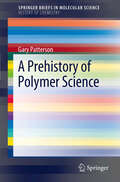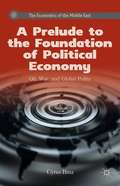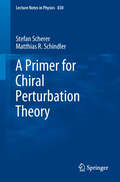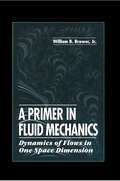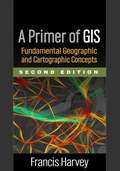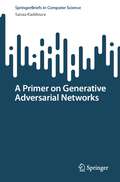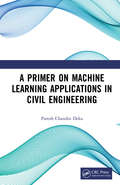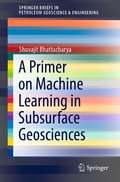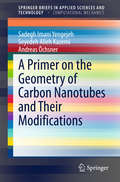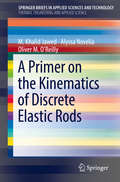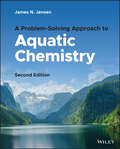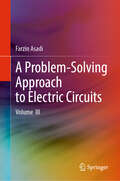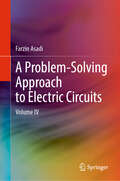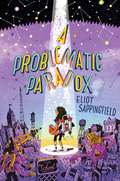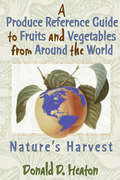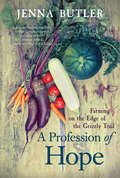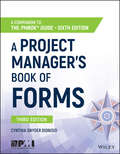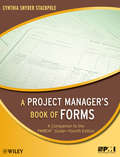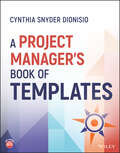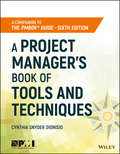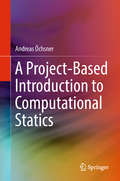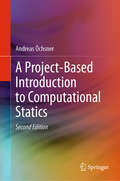- Table View
- List View
A Prehistory of Polymer Science (SpringerBriefs in Molecular Science #2)
by Gary Patterson Carnegie Mellon UniversityPolymer science is now an active and thriving community of scientists, engineers and technologists, but there was a time, not so long ago, when there was no such community. The prehistory of polymer science helps to provide key insights into current issues and historical problems. The story will be divided into an ancient period ( from Greek times to the creation of the molecular consensus), a nascent period (from Dalton to Kekule to van't Hoff) and a period of paradigm formation and controversy (from Staudinger to Mark to Carothers). The prehistory concludes with an account of the epochal 1935 Discussion of the Faraday Society on "Polymerization". After this meeting an active community engaged in trying to solve the central problems defined by the discussions.
A Prelude to the Foundation of Political Economy
by Cyrus BinaA Prelude to the Foundation of Political Economy is a groundbreaking volume of theory and strategy on political economy and polity of the twenty-first century. Distilled in concrete terms, it elucidates the enigma of oil in view of the centrality of global social relations.
A Primer for Chiral Perturbation Theory (Lecture Notes in Physics #830)
by Stefan Scherer Matthias R. SchindlerChiral Perturbation Theory, as effective field theory, is a commonly accepted and well established working tool, approximating quantum chromodynamics at energies well below typical hadron masses. This volume, based on a number of lectures and supplemented with additional material, provides a pedagogical introduction for graduate students and newcomers entering the field from related areas of nuclear and particle physics. Starting with the the Lagrangian of the strong interactions and general symmetry principles, the basic concepts of Chiral Perturbation Theory in the mesonic and baryonic sectors are developed. The application of these concepts is then illustrated with a number of examples. A large number of exercises (81, with complete solutions) are included to familiarize the reader with helpful calculational techniques.
A Primer in Fluid MechanicsDynamics of Flows in One Space Dimension
by Jr. BrowerThis distinctive text presents the basic principles of fluid mechanics by means of one-dimensional flow examples - differing significantly in style and content from other books. A Primer in Fluid Mechanics contains:an overview of fluid properties and the kinetic theory of gases information on the fundamental equations of fluid mechanics, including historical references and background information introductory discussions on fluid properties and fluid statics a comprehensive chapter on compressible flow a variety of applications on non-steady flow, including non-steady gas dynamics a brief introduction to acousticsNovel provisos in the text include an analysis of the static stability of a floating two-dimensional parabolic section viscous flow through an elastic duct several geometries in non-steady tank draining, including a singular perturbation problemChapters also discuss physical properties, atmospheric stability, thermodynamics, energy and momentum equations, dimensional analysis, and historical perspectives of flows in pipes and conduits.A Primer in Fluid Mechanics offers a rigorous text for the curious student and for the research engineer seeking a readily available guide to the more refined treatments in the literature - supporting classical and current discussions as well as theoretical and practical concepts.
A Primer of GIS, Second Edition
by Francis HarveyThis accessible text prepares students to understand and work with geographic information systems (GIS), offering a detailed introduction to essential theories, concepts, and skills. The book is organized in four modular parts that can be used in any sequence in entry-level and more specialized courses. Basic cartographic principles are integrated with up-to-date discussions of GIS technologies and applications. Coverage includes everything from what geographic information is to its many uses and societal implications. Practical examples and exercises invite readers to explore the choices involved in producing reliable maps and other forms of geographic information. Illustrations include 170 figures (with 15 in color). The companion website provides links to Web resources for each chapter, plus downloadable PowerPoint slides of most of the figures. New to This Edition *Chapter on online mapping and Big Data. *New and updated discussions of remote sensing, vector and raster data models, location privacy, uses of geocoding, and other timely topics. *Chapter on the many uses of GIS, such as in market analyses, emergency responding, and tracking of epidemics. *Section overviews and an end-of-book glossary. Pedagogical Features *Modules and individual chapters can be used sequentially or in any order. *End-of-chapter review questions with answers, exercises, and extended exercises for applying theories and concepts. *"In-Depth" sidebars offering a closer look at key concepts and applications. *End-of-chapter links to relevant Web resources.
A Primer on Electric Vehicles in India: A Machine-Generated Literature Overview
by Saon Ray Deb MukherjiThis book presents the result of an innovative challenge, to create a systematic literature overview driven by machine-generated content. Questions and related keywords were prepared for the machine to query, discover, collate and structure by Artificial Intelligence (AI) clustering. The AI-based approach seemed especially suitable to provide an innovative perspective as the topics are indeed both complex, interdisciplinary and multidisciplinary, for example, climate, planetary and evolution sciences. Springer Nature has published much on these topics in its journals over the years, so the challenge was for the machine to identify the most relevant content and present it in a structured way that the reader would find useful. The automatically generated literature summaries in this book are intended as a springboard to further discoverability. They are particularly useful to readers with limited time, looking to learn more about the subject quickly and especially if they are new to the topics. Springer Nature seeks to support anyone who needs a fast and effective start in their content discovery journey, from the undergraduate student exploring interdisciplinary content to Master- or PhD-thesis developing research questions, to the practitioner seeking support materials, this book can serve as an inspiration, to name a few examples. It is important to us as a publisher to make the advances in technology easily accessible to our authors and find new ways of AI-based author services that allow human-machine interaction to generate readable, usable, collated, research content.
A Primer on Fiscal Analysis in Oil-Producing Countries
by Paulo Medas Daria ZakharovaA report from the International Monetary Fund.
A Primer on Fluid Mechanics with Applications
by Sudhir Ranjan Jain Bhooshan S. Paradkar Shashikumar M. ChitreThis textbook is a pedagogic introduction to a number of phenomena employing fluid mechanics. Beginning with basic concepts and conservation laws for neutral and charged fluids, the authors apply and develop them to understand aerodynamics, locomotion of micro-organisms, waves in air and water, shock waves, hydrodynamic and hydromagnetic instabilities, stars and black holes, blood flow in humans, and superfluids. The approach is to consider various striking topics on fluid mechanics, without losing necessary mathematical rigor. The book balances the qualitative explanations with formal treatment, in a compact manner. A special focus is given to the important and difficult subject of turbulence and the book ends with a discussion on turbulence in quantum fluids. The textbook is dotted by a number of illustrative examples, mostly from real life, and exercises. The textbook is designed for a one semester course and addresses students at undergraduate and graduate level in physics or engineering, who want to research in the fields as diverse as aeronautics, meteorology, cosmology, biomechanics, and mathematical physics. It is requested knowledge of an undergraduate level course on mathematical methods to better understand the topics presented here.
A Primer on Generative Adversarial Networks (SpringerBriefs in Computer Science)
by Sanaa KaddouraThis book is meant for readers who want to understand GANs without the need for a strong mathematical background. Moreover, it covers the practical applications of GANs, making it an excellent resource for beginners. A Primer on Generative Adversarial Networks is suitable for researchers, developers, students, and anyone who wishes to learn about GANs. It is assumed that the reader has a basic understanding of machine learning and neural networks. The book comes with ready-to-run scripts that readers can use for further research. Python is used as the primary programming language, so readers should be familiar with its basics.The book starts by providing an overview of GAN architecture, explaining the concept of generative models. It then introduces the most straightforward GAN architecture, which explains how GANs work and covers the concepts of generator and discriminator. The book then goes into the more advanced real-world applications of GANs, such as human face generation, deep fake, CycleGANs, and more.By the end of the book, readers will have an essential understanding of GANs and be able to write their own GAN code. They can apply this knowledge to their projects, regardless of whether they are beginners or experienced machine learning practitioners.
A Primer on Machine Learning Applications in Civil Engineering
by Paresh Chandra DekaMachine learning has undergone rapid growth in diversification and practicality, and the repertoire of techniques has evolved and expanded. The aim of this book is to provide a broad overview of the available machine-learning techniques that can be utilized for solving civil engineering problems. The fundamentals of both theoretical and practical aspects are discussed in the domains of water resources/hydrological modeling, geotechnical engineering, construction engineering and management, and coastal/marine engineering. Complex civil engineering problems such as drought forecasting, river flow forecasting, modeling evaporation, estimation of dew point temperature, modeling compressive strength of concrete, ground water level forecasting, and significant wave height forecasting are also included. Features Exclusive information on machine learning and data analytics applications with respect to civil engineering Includes many machine learning techniques in numerous civil engineering disciplines Provides ideas on how and where to apply machine learning techniques for problem solving Covers water resources and hydrological modeling, geotechnical engineering, construction engineering and management, coastal and marine engineering, and geographical information systems Includes MATLAB® exercises
A Primer on Machine Learning in Subsurface Geosciences (SpringerBriefs in Petroleum Geoscience & Engineering)
by Shuvajit BhattacharyaThis book provides readers with a timely review and discussion of the success, promise, and perils of machine learning in geosciences. It explores the fundamentals of data science and machine learning, and how their advances have disrupted the traditional workflows used in the industry and academia, including geology, geophysics, petrophysics, geomechanics, and geochemistry. It then presents the real-world applications and explains that, while this disruption has affected the top-level executives, geoscientists as well as field operators in the industry and academia, machine learning will ultimately benefit these users. The book is written by a practitioner of machine learning and statistics, keeping geoscientists in mind. It highlights the need to go beyond concepts covered in STAT 101 courses and embrace new computational tools to solve complex problems in geosciences. It also offers practitioners, researchers, and academics insights into how to identify, develop, deploy, and recommend fit-for-purpose machine learning models to solve real-world problems in subsurface geosciences.
A Primer on the Geometry of Carbon Nanotubes and Their Modifications (SpringerBriefs in Applied Sciences and Technology)
by Andreas Öchsner Sadegh Imani Yengejeh Seyedeh Alieh KazemiThis volume presents a comprehensive system for categorizing carbon nanotubes and their modifications in terms of nano sheets, nanotubes, microscopic and atomic modifications. In addition, the material and geometric properties of these nano-configurations are addressed. Lastly, it introduces a number of common software packages for geometry generation and several commercial finite element programs.
A Primer on the Kinematics of Discrete Elastic Rods (SpringerBriefs in Applied Sciences and Technology)
by Oliver M. O'Reilly M. Khalid Jawed Alyssa NoveliaThis primer discusses a numerical formulation of the theory of an elastic rod, known as a discrete elastic rod, that was recently developed in a series of papers by Miklós Bergou et al. Their novel formulation of discrete elastic rods represents an exciting new method to simulate and analyze the behavior of slender bodies that can be modeled using an elastic rod. The formulation has been extensively employed in computer graphics and is highly cited. In the primer, we provide relevant background from both discrete and classical differential geometry so a reader familiar with classic rod theories can appreciate, comprehend, and use Bergou et al.’s computational efficient formulation of a nonlinear rod theory. The level of coverage is suitable for graduate students in mechanics and engineering sciences.
A Problem-Solving Approach to Aquatic Chemistry
by James N. JensenA Problem-Solving Approach to Aquatic Chemistry Enables civil and environmental engineers to understand the theory and application of aquatic equilibrium chemistry The second edition of A Problem-Solving Approach to Aquatic Chemistry provides a detailed introduction to aquatic equilibrium chemistry, calculation methods for systems at equilibrium, applications of aquatic chemistry, and chemical kinetics. The text directly addresses two required ABET program outcomes in environmental engineering: “… chemistry (including stoichiometry, equilibrium, and kinetics)” and “material and energy balances, fate and transport of substances in and between air, water, and soil phases.” The book is very student-centered, with each chapter beginning with an introduction and ending with a summary that reviews the chapter’s main points. To aid in reader comprehension, important terms are defined in context and key ideas are summarized. Many thought-provoking discussion questions, worked examples, and end of chapter problems are also included. Each part of the text begins with a case study, a portion of which is addressed in each subsequent chapter, illustrating the principles of that chapter. In addition, each chapter has an Historical Note exploring connections with the people and cultures connected to topics in the text. A Problem-Solving Approach to Aquatic Chemistry includes: Fundamental concepts, such as concentration units, thermodynamic basis of equilibrium, and manipulating equilibria Solutions of chemical equilibrium problems, including setting up the problems and algebraic, graphical, and computer solution techniques Acid–base equilibria, including the concepts of acids and bases, titrations, and alkalinity and acidity Complexation, including metals, ligands, equilibrium calculations with complexes, and applications of complexation chemistry Oxidation-reduction equilibria, including equilibrium calculations, graphical approaches, and applications Gas–liquid and solid–liquid equilibrium, with expanded coverage of the effects of global climate change Other topics, including chemical kinetics of aquatic systems, surface chemistry, and integrative case studies For advanced/senior undergraduates and first-year graduate students in environmental engineering courses, A Problem-Solving Approach to Aquatic Chemistry serves as an invaluable learning resource on the topic, with a variety of helpful learning elements included throughout to ensure information retention and the ability to apply covered concepts in practical settings.
A Problem-Solving Approach to Electric Circuits: Volume III
by Farzin AsadiThis book is designed for students taking circuit analysis courses. It includes examples and exercises that help students review and sharpen their knowledge of the subject while enhancing their classroom performance. Offering detailed solutions, multiple methods for solving problems, and clear explanations of concepts, this book aims to improve students' problem-solving skills and deepen their understanding of topics covered in electric circuit analysis courses.
A Problem-Solving Approach to Electric Circuits: Volume IV
by Farzin AsadiThis book is designed for students taking circuit analysis courses. It includes examples and exercises that help students review and sharpen their knowledge of the subject while enhancing their classroom performance. Offering detailed solutions, multiple methods for solving problems, and clear explanations of concepts, this book aims to improve students' problem-solving skills and deepen their understanding of topics covered in electric circuit analysis courses.
A Problematic Paradox
by Eliot SappingfieldGuardians of the Galaxy meets The Hitchhiker's Guide to the Galaxy in this wild, warm-hearted, and hilarious sci-fi debut about a brainy young girl who is recruited for a very special boarding school. <P><P> Nikola Kross has given up on living in harmony with classmates and exasperated teachers: she prefers dabbling in experimental chemistry to fitting in. But when her life is axially inverted by a gang of extraterrestrials who kidnap her dad and attempt to recruit her into their service, she discovers he's been keeping a world of secrets from her--including the school for geniuses where she's sent for refuge, a place where classes like Practical Quantum Mechanics are the norm and where students use wormholes to commute to class. For Nikola, the hard part isn't school, it's making friends, especially when the student body isn't (entirely) human. <P><P> But the most puzzling paradox of all is Nikola herself, who has certain abilities that no one understands--abilities that put her whole school in greater danger than she could have imagined.* <P><P> "A glorious cacophony of wildly inventive gadgets, gags, and action." --Kirkus Reviews, starred review
A Produce Reference Guide to Fruits and Vegetables from Around the World: Nature's Harvest
by Donald D HeatonA Produce Reference Guide to Fruits and Vegetables from Around the World: Nature's Harvest answers the many questions consumers have about various fruits and vegetables. Providing basic, clear, and understandable information for each produce item, this reference guide gives you a synopsis of the fruit or vegetable, a short history of the item, the common and uncommon name, what it looks and tastes like, how it is used, and the time of year it is available. Information on nutrition, serving sizes, yields, and optimal storage conditions is also provided. From potatoes to shepherd's purse and from grapes to the Clementine tangor, A Produce Reference Guide to Fruits and Vegetables from Around the World covers both the familiar and the exotic. Other than the obvious fruits and vegetables (such as 12 varieties of cherries and 10 different kinds of squash) you'll also read about herbs, mushrooms, sprouts, and nuts.
A Profession of Hope: Farming on the Edge of the Grizzly Trail
by Jenna ButlerFinalist:High Plain Book Award, Creative Nonfiction"This is not the story of a ready-made farm, complete with generations of history, carefully tended tools and sturdy clapboard farmhouse." In 2006 Jenna Butler and her partner, Thomas, purchased "160 acres more or less" of rough northern bush. They knew they weren't purchasing anything more than hard work and hope but still they headed up every weekend to clear a spot in those woods where they could plant their first crops. In this collection Butler talks of the hardships, humor and grace notes of trying to build a northern farm. From being driven out by mosquitoes to thwarting grasshoppers to sublime moments under a night sky, Jenna tells the story of how the farm has grown and changed over the years. While it has never quite become viable, it has pulled her always deeper into her love of the land. Jenna also talks about her reasons for starting a farm, poking fun at her own dyed-in-the-wool idealism. She explains her desire to protect and preserve the land, touching on the impact of climate change and of the wear and tear of trying to make a go of it as a small farmer. This is a beautifully written book, one that will leave readers wanting to start their own farm.
A Project Manager's Book of Forms: A Companion to the PMBOK Guide
by Cynthia Snyder DionisioEssential project management forms aligned to the PMBOK® Guide—Sixth Edition A Project Manager's Book of Forms is an essential companion to the Project Management Institute's A Guide to the Project Management Body of Knowledge. Packed with ready-made forms for managing every stage in any project, this book offers both new and experienced project managers an invaluable resource for thorough documentation and repeatable processes. Endorsed by PMI and aligned with the PMBOK® Guide, these forms cover all aspects of initiating, planning, executing, monitoring and controlling, and closing; each form can be used as-is directly from the book, or downloaded from the companion website and tailored to your project's unique needs. This new third edition has been updated to align with the newest PMBOK® Guide, and includes forms for agile, the PMI Talent Triangle, technical project management, leadership, strategic and business management, and more. The PMBOK® Guide is the primary reference for project management, and the final authority on best practices—but implementation can quickly become complex for new managers on large projects, or even experienced managers juggling multiple projects with multiple demands. This book helps you stay organized and on-track, helping you ensure thorough documentation throughout the project life cycle. Adopt PMI-endorsed forms for documenting every process group Customize each form to suit each project's specific needs Organize project data and implement a repeatable management process Streamline PMBOK® Guide implementation at any level of project management experience Instead of wasting time interpreting and translating the PMBOK® Guide to real-world application, allow PMI to do the work for you: A Project Manager's Book of Forms provides the PMBOK®-aligned forms you need to quickly and easily implement project management concepts and practices.
A Project Manager's Book of Forms: A Companion to the PMBOK Guide
by Cynthia Snyder StackpoleThis source book of forms and procedures for using them follows exactly the content of the PMBOK® Guide. It provides a road-map approach so readers know exactly where they are and what forms precede and follow their current position on a project. The volume contains forms in hard copy for reproduction as well as in an accompanying CD for use and customization by a wide variety of project managers, consultants, and other associated professionals. (PMBOK is a registered mark of the Project Management Institute, Inc.)
A Project Manager's Book of Templates
by Cynthia Snyder DionisioA PROJECT MANAGER'S BOOK OF TEMPLATES A helpful compendium of ready-made templates for managing every project in alignment with the latest PMBOK® Guide, 7th ed. Project Management is a growing discipline that has seen considerable recent development. Project managers are now expected to deploy predictive and adaptive methods, and to draw upon a considerable base of knowledge in developing and formalizing project plans. The Project Management Institute (PMI) publishes the authoritative Project Management Body of Knowledge (PMBOK® Guide), which contains the global standard for the Project Management profession. A Project Manager&’s Book of Templates is a vital companion to the PMBOK® Guide, providing a comprehensive set of templates and reports that helps project managers translate the content of the Guide into practical applications. It promises to be an indispensable resource for professionals in this fast-moving field. A Project Manager's Book of Templates readers will also find: Templates covering all types of work, such as starting, planning, project documents, logs and registers, and reports and audits. Templates representing all updated features of the PMBOK® Guide, including hybrid, adaptive and iterative practices, including Agile Easy, readable structure that moves project managers through the different types of work that is performed in project A Project Manager&’s Book of Templates isan essential companion for those preparing for the PMP Certification Exam, as well as practitioners and consultants to a range of global industries.
A Project Manager's Book of Tools and Techniques
by Cynthia Snyder DionisioA practical guide for putting PMBOK concepts to work A Project Manager’s Book of Tools and Techniques is an invaluable resource for students and working professionals alike. Whether you’re preparing for the PMP exam or just looking to optimize your project management skills, this book provides detailed explanations for over 100 essential tools described in the Project Management Institute’s A Guide to the Project Management Body of Knowledge (PMBOK Guide) Sixth Edition. Going beyond theory and concept to real-world practice, these tools and techniques are the “how” of effective project management; from planning, to implementation, to oversight, and beyond, all phases of the project are represented here to help you more effectively apply critical PMBOK concepts. Comprehensive examples illustrate real-world implementation, and detailed discussion provides expert guidance for both new and experienced project management professionals. Knowing what to do is much different from knowing how to do it; even perfect understanding of the PMBOK Guide doesn’t automatically translate into effective practice. This book is designed to help you bridge that gap and expertly apply current project management standards. Delve deeper into the practical tools described in the PMBOK Guide—Sixth Edition Follow detailed examples that illustrate effective project management methods Master project management applications in preparation for the PMP exam Graduate from theory to practice with powerful tools and techniques for success Concepts are only valuable once they are applied—and then they become a skill set that gets results. The PMBOK Guide is the ultimate authority on project management concepts, but translating those concepts into applicable skills requires a detailed understanding of the tools of the field. A Project Manager’s Book of Tools and Techniques is a practical manual for putting essential project management concepts into practice.
A Project-Based Introduction to Computational Statics
by Andreas ÖchsnerThis book uses a novel concept to teach the finite element method, applying it to solid mechanics. This major conceptual shift takes away lengthy theoretical derivations in the face-to-face interactions with students and focuses on the summary of key equations and concepts; and to practice these on well-chosen example problems. The theoretical derivations are provided as additional reading and students must study and review the derivations in a self-study approach. The book provides the theoretical foundations to solve a comprehensive design project in tensile testing. A classical clip-on extensometer serves as the demonstrator on which to apply the provided concepts. The major goal is to derive the calibration curve based on different approaches, i.e., analytical mechanics and based on the finite element method, and to consider further design questions such as technical drawings, manufacturing, and cost assessment. Working with two concepts, i.e., analytical and computational mechanics strengthens the vertical integration of knowledge and allows the student to compare and understand the different concepts, as well as highlighting the essential need for benchmarking any numerical result.
A Project-Based Introduction to Computational Statics
by Andreas ÖchsnerThis book uses a novel concept to teach the finite element method, applying it to solid mechanics. This major conceptual shift takes away lengthy theoretical derivations in the face-to-face interactions with students and focuses on the summary of key equations and concepts; and to practice these on well-chosen example problems. For this new, 2nd edition, many examples and design modifications have been added, so that the learning-by-doing features of this book make it easier to understand the concepts and put them into practice. The theoretical derivations are provided as additional reading and students must study and review the derivations in a self-study approach. The book provides the theoretical foundations to solve a comprehensive design project in tensile testing. A classical clip-on extensometer serves as the demonstrator on which to apply the provided concepts. The major goal is to derive the calibration curve based on different approaches, i.e., analytical mechanics and based on the finite element method, and to consider further design questions such as technical drawings, manufacturing, and cost assessment. Working with two concepts, i.e., analytical and computational mechanics strengthens the vertical integration of knowledge and allows the student to compare and understand the different concepts, as well as highlighting the essential need for benchmarking any numerical result.
